Butterflies of the Adirondacks:
Mourning Cloak (Nymphalis antiopa)
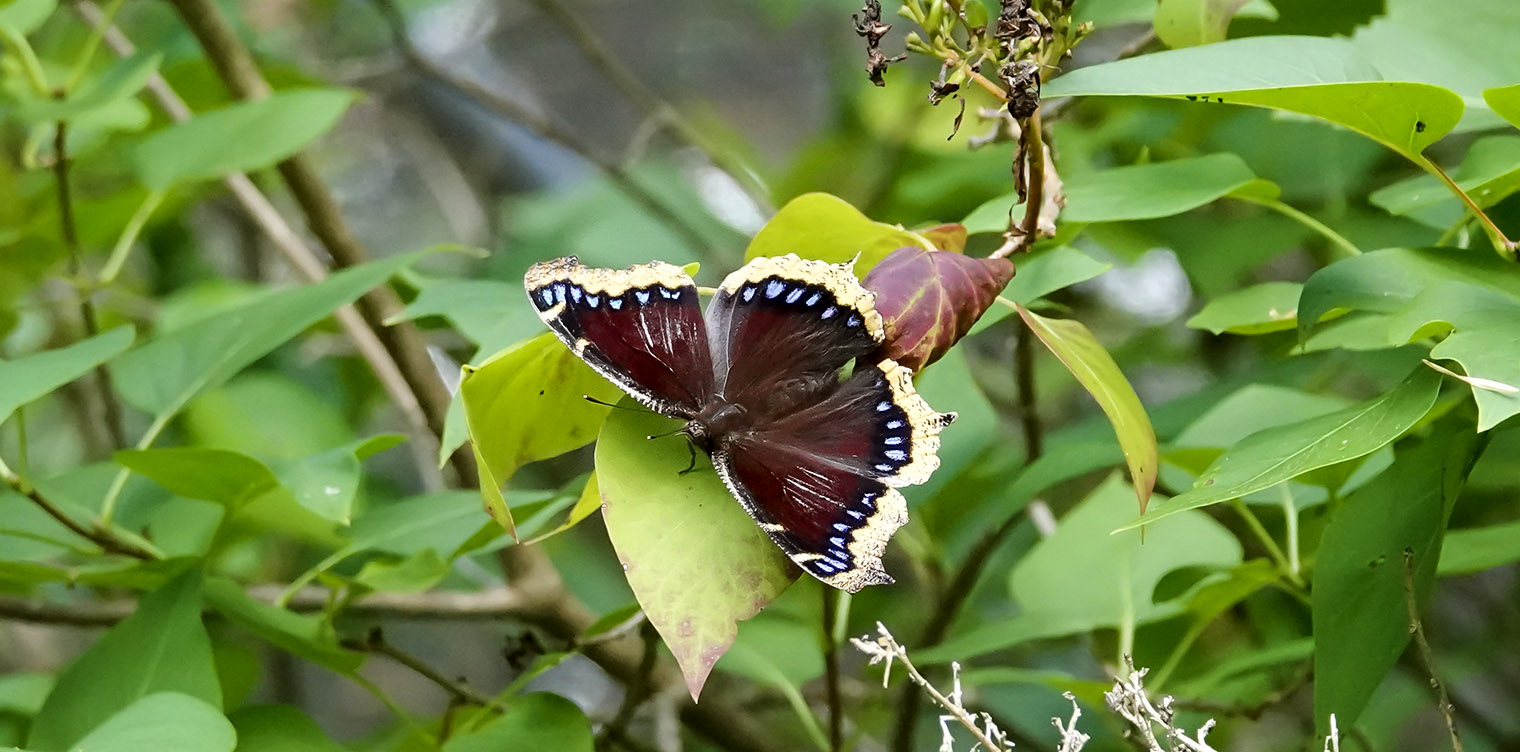
The Mourning Cloak (Nymphalis antiopa) is a large, dark maroon butterfly with a cream band seen in the Adirondacks in early spring, summer, and early fall.
Mourning Cloaks are classified as True Brushfoots, a large category which also includes Pearl Crescent, Northern Crescent, Baltimore Checkerspot, Harris' Checkerspot, Milbert's Tortoiseshell, Eastern Comma, Question Mark, Red Admiral, Painted Lady, American Lady. [1] [2]
- The species name (antiopa) is said to be derived from Antiope, a character in Greek mythology. [3]
- In the caterpillar stage, this species has been referred to as the Spring Elm Caterpillar. [4]
Mourning Cloak: Identification
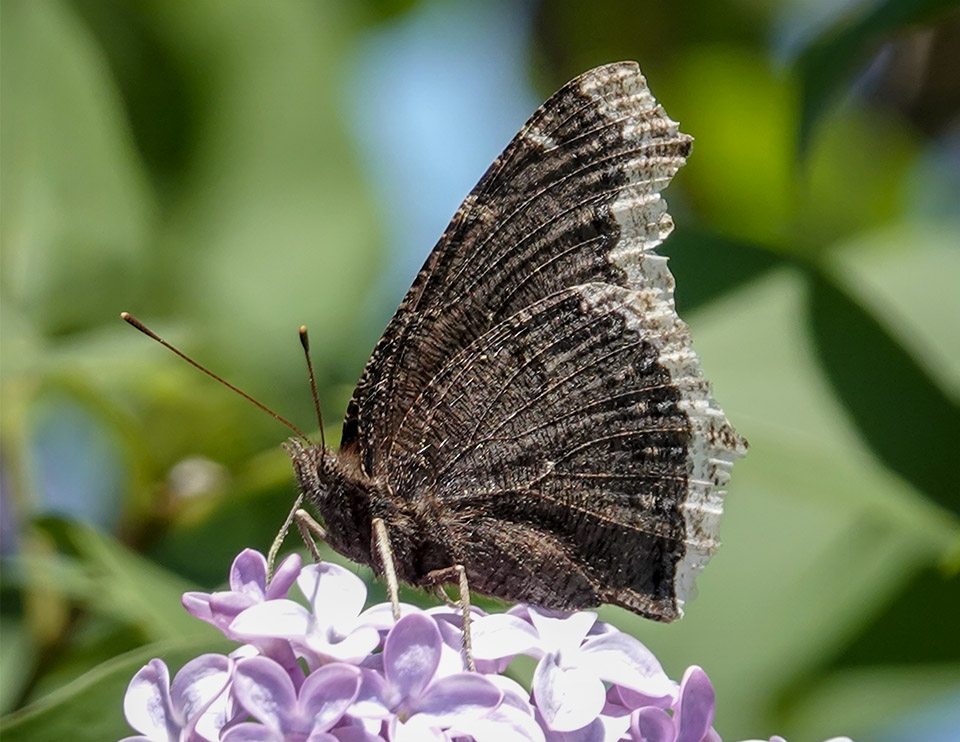
Adult Mourning Cloaks are large butterflies. With a wingspan of 2⅞ to 3⅜ inches, [5] [6] they are somewhat smaller than a Monarch, but significantly larger than a Cabbage White. The marginMargin: The edge of the wing. (edges) of their wings are irregular or ragged. [7] There is limited geographic variation in their appearance, although Mourning Cloaks in the north tend to be smaller than those in the south. [8 [9]
- From above (the dorsal surfaceDorsal surface: The top side of a wing. ), which is seen when the butterfly rests with its wings open, the Mourning Cloak is a velvety dark maroon, with a bright light yellow or cream colored band. [10] Above the band is a row of oblong blue spots. [11] There is a whitish spot near the apexApex: The tip of a butterfly's wing. (tip) of the fore wing. [12] The borders may be faded and whitish as the butterfly becomes worn. [13] There are short tail-like projections on the hind wings. [14 These may erode and become less obvious with wear. [15]
- From below (the ventral surfaceVentral surface: The underside of a wing. ), which is seen when the butterfly rests with closed wings, the Mourning Cloak is a striated ash-black, with a dirty yellow or tan border. [16] [17]
Like other butterflies, Mourning Cloaks go through a complete metamorphosis from egg, to caterpillar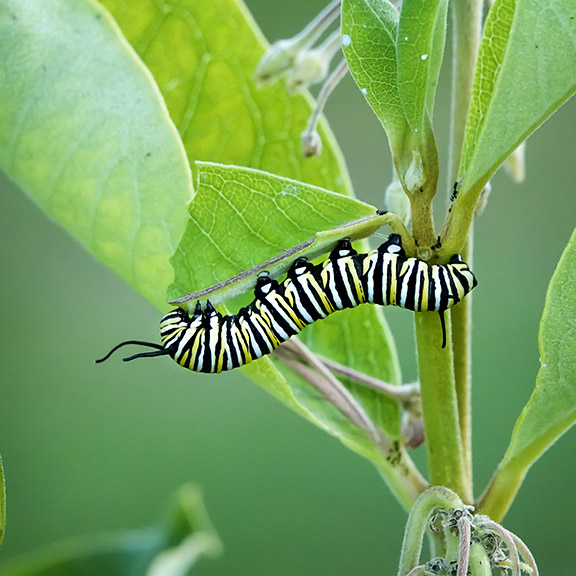 Caterpillar: Butterflies and moths develop through a process called metamorphosis, which entails four states: eggs, caterpillar (larva), pupa, and adult. The caterpillar, representing the second state in the life cycle, hatches from the egg. Its primary activity is eating. The caterpillars first eats its eggshell and then begins consuming the leaves on which the egg was laid. Newly-born caterpillars are very small and expand as they start growing. Because the exoskeleton does not stretch, the caterpillar grows by molting (shedding its skin). The stages between larval molts are called instars., to chrysalisChrysalis: The hard outer shell of a pupa., to adult. Mourning Cloak eggs are white, becoming tan when they are about to hatch. [18] The eggs are shaped like a turban, with seven or eight vertical ribs. [19]
Caterpillar: Butterflies and moths develop through a process called metamorphosis, which entails four states: eggs, caterpillar (larva), pupa, and adult. The caterpillar, representing the second state in the life cycle, hatches from the egg. Its primary activity is eating. The caterpillars first eats its eggshell and then begins consuming the leaves on which the egg was laid. Newly-born caterpillars are very small and expand as they start growing. Because the exoskeleton does not stretch, the caterpillar grows by molting (shedding its skin). The stages between larval molts are called instars., to chrysalisChrysalis: The hard outer shell of a pupa., to adult. Mourning Cloak eggs are white, becoming tan when they are about to hatch. [18] The eggs are shaped like a turban, with seven or eight vertical ribs. [19]
The caterpillar Caterpillar: Butterflies and moths develop through a process called metamorphosis, which entails four states: eggs, caterpillar (larva), pupa, and adult. The caterpillar, representing the second state in the life cycle, hatches from the egg. Its primary activity is eating. The caterpillars first eats its eggshell and then begins consuming the leaves on which the egg was laid. Newly-born caterpillars are very small and expand as they start growing. Because the exoskeleton does not stretch, the caterpillar grows by molting (shedding its skin). The stages between larval molts are called instars. of the Mourning Cloak is black with a row of eight red/orange patches down the back. [20] It is speckled with white spots and has black spines when mature. [21] The head is black and without spines. [22] The caterpillar is about two inches long. [23]
Caterpillar: Butterflies and moths develop through a process called metamorphosis, which entails four states: eggs, caterpillar (larva), pupa, and adult. The caterpillar, representing the second state in the life cycle, hatches from the egg. Its primary activity is eating. The caterpillars first eats its eggshell and then begins consuming the leaves on which the egg was laid. Newly-born caterpillars are very small and expand as they start growing. Because the exoskeleton does not stretch, the caterpillar grows by molting (shedding its skin). The stages between larval molts are called instars. of the Mourning Cloak is black with a row of eight red/orange patches down the back. [20] It is speckled with white spots and has black spines when mature. [21] The head is black and without spines. [22] The caterpillar is about two inches long. [23]
The Mourning Cloak chrysalisChrysalis: The hard outer shell of a pupa. is around ⅞ inches long. [24] It ranges in color from brown to blackish gray to whitish tan, [25] with two head horns. It resembles a dried, shriveled leaf. [26] It hangs upside down.
Mourning Cloak: Life History
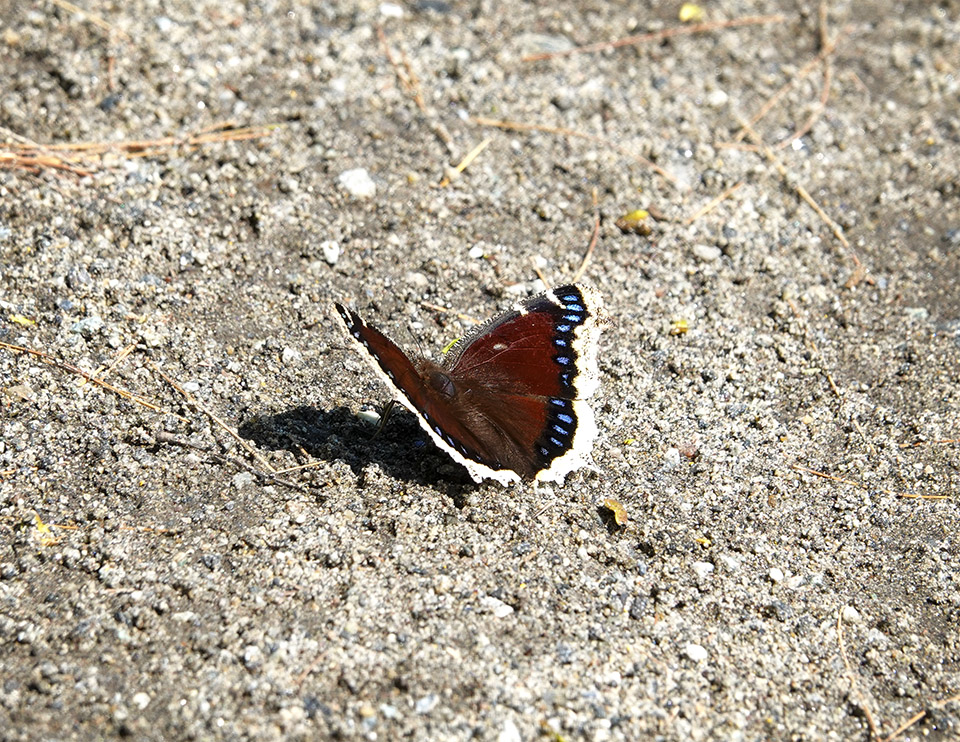
With a lifespan of 10-11 months, the Mourning Cloak is our longest-living butterfly. [27] Overwintering as adults, these butterflies emerge from hibernation in spring to mate. They are often one of the first butterflies to be seen in the spring. They feed briefly, and then go into estivationEstivation: A state of animal dormancy, similar to hibernation, which occurs in summer. Both vertebrates and invertebrates may undergo estivation, which is characterized by inactivity and a lowered metabolic rate. (dormancy) for much of the summer.
Adult Mourning Cloaks emerge from hibernation in April. [28] Sources conflict on behavior during the mating process. Some sources indicate that the males patrol forest clearings and roads in the afternoon, looking for females. [29] Others suggest that the males perch in sunny openings during the afternoon, awaiting receptive females. [30] [31]
Female Mourning Cloaks lay their eggs in large, single-layer clusters. [32] After emerging from the eggs, the caterpillars eat willow, [33] [34] as well as other trees and shrubs including Trembling Aspen, American Elm, and Paper Birch. [35] [36]
The caterpillars live communally in a web, [37] feeding together on young foliage. [38] When disturbed, they thrash about in an effort to deter predators. [39] Older caterpillars may wander and can be found far from their host plant. [40] They often move off their host plant to pupatePupate: to transform from a caterpillar to a chrysalis. (transform into a chrysalis), emerging in June or July after about 11 days . [41] [42]
Adult Mourning Cloaks feed briefly, mainly on tree sap and rotting fruit, but occasionally on flower nectar. [43] Trees with active sap flows made available by sapsuckers may be visited every day, often in the morning. Mourning Cloaks feed with their head downward. [44] This species may also nectar occasionally on flowers and have been observed on Common Milkweed and dogbane.
When the weather is cool, Mourning Cloaks, like many other butterflies, warm themselves through basking, usually on the ground with their wings open. They may also be seen perched on the ground or on tree trunks with their wings closed. Their brown, striated wings and irregular wing margins give them with excellent camouflage from would-be predators.
After a period of feeding after emerging from the chrysalis, the adults go into dormancy, taking shelter in a hollow tree or other sheltered location until the fall. They then emerge to feed and store energy for hibernation, retreating again to hollow trees and woodpiles for the winter months. [45] Mourning Cloaks sometimes emerge from their sheltered nooks on warm winter days, tolerating the winter cold by shivering to raise their body temperature. [46] [47] Some sources indicate that a portion of the population migrates southward. [48] [50]
Mourning Cloak: Habitat and Range
The range of the Mourning Cloak is extensive. This butterfly is found throughout the continent south to central Mexico. It also occurs in temperate Eurasia. [51] [52]
In terms of habitat, the Mourning Cloak is a generalist. [53] It is primarily a butterfly of woodlands, particularly hardwood forest). [54] [55] [56] However, it is highly adaptable, wandering through a broad range of habitats. [57] This species can be found almost anywhere its host plants occur, including backyard gardens, parks, fields, roadsides, watercourses, and swamp edges. [58]
Mourning Cloak: Flight
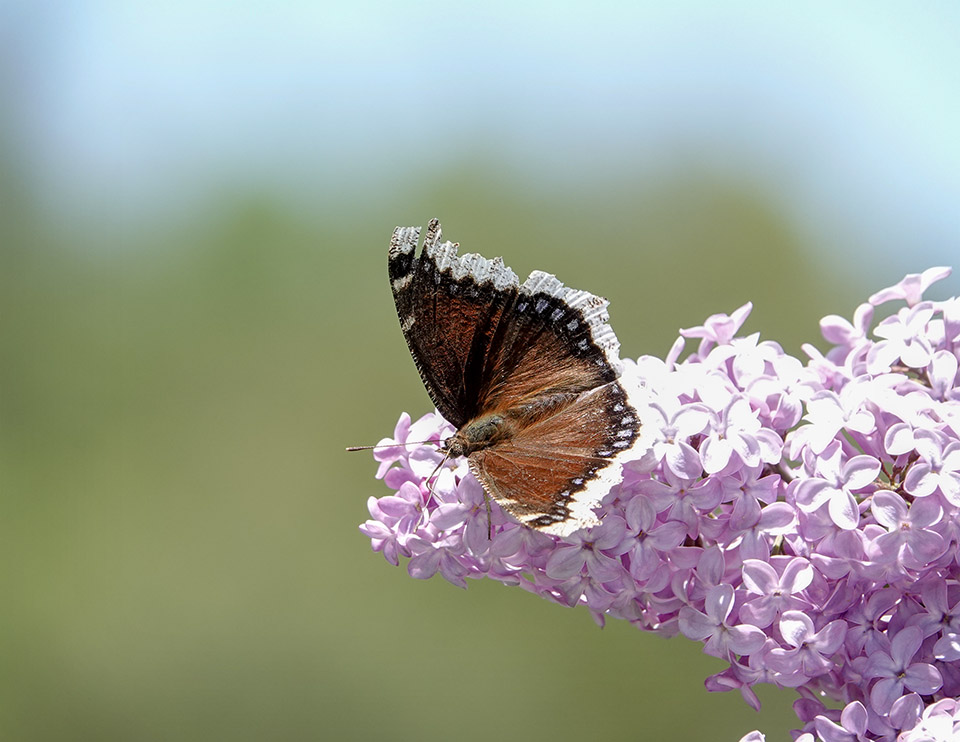
The flight period of Mourning Cloaks, as with all butterflies, varies with region and probably shifts from year to year. The number of broodsBrood: A single generation of butterflies, hatched from the eggs laid by females of the previous generation. Members of a brood fly during roughly the same time period. varies with latitude and altitude, with one brood in the northern parts of the Mourning Cloak's Range and two or three in the southern areas. [59] [60]
- In Wisconsin, the Mourning Cloak has one broodBrood: A single generation of butterflies, hatched from the eggs laid by females of the previous generation. Members of a brood fly during roughly the same time period. which reportedly emerges in July and flies throughout the summer and fall before hibernating and emerging in spring to mate. [61]
- In Montana, there is one flight in the far north and mountains, with highest numbers seen in late July. [62]
- Mourning Cloaks fly in Massachusetts from late March to late October. [63] This species has been seen flying before the snow has fully melted. Peaks in abundance occur in the first week of May and the second week of July. [64]
- In Vermont, there is one broodBrood: A single generation of butterflies, hatched from the eggs laid by females of the previous generation. Members of a brood fly during roughly the same time period. flying from very late March through mid-October, with the highest numbers in July. [65]
- In Canada, there are two generations per year in Ontario. In the mixed forest area, this butterfly is seen from March to mid-October, with the highest numbers in mid-April and early May. [66]
- In the New York City area, adult Mourning Warblers are seen from March through early June, with a few flying in late July, September, and early October. [67]
The flight period and abundance of the Mourning Cloak within the Adirondack Park can only be roughly estimated, based mainly on a very limited number of verified sightings on Butterflies and Moths of North America (BAMONA) and a small number of reported observations of adult Mourning Cloaks on iNaturalist.
- The advantage of iNaturalist is that it is a popular citizen science web site that attracts many contributors, in part because it covers both plants and animals (making it easy for people to record all of their observations in one place) and in part because the process of submitting an observation is very easy. The disadvantage is that an individual observation can achieve "research-grade" status by having the identification confirmed by the observer and one additional individual, who may or may not have expertise in that particular taxon.
- The advantage of BAMONA is that sightings are verified by regional specialists who are recognized experts. The disadvantage is that there are fewer sighting records for many species, partly because the site covers only butterflies and moths and partly because the process of submitting a sighting is more time-consuming.
- Both data sets share a common problem of citizen science: reported trends may reflect trends in the number of observers and their willingness to submit reports, not the abundance of the butterfly in question.
With these caveats in mind, it appears that Mourning Cloaks are on the wing in the Adirondack Park from early April to mid-September.
- Mourning Cloaks have been rare guests at the Paul Smith's College VIC Native Species Butterfly House, which collects its butterfly and moth residents from the immediate area. [68] This species was not listed in the Daily Species Checklist for either 2012 or 2016. In 2013, this species appeared in late June. In 2015, a Mourning Cloak was present in the Butterfly House from mid- to late June. (Logbooks for 2014 were not available.)
- BAMONA lists 93 verified sightings of Mourning Cloaks in New York State; 16 are in one of the twelve counties with area within the Adirondack Park. The Adirondack sightings of adult Mourning Cloaks range from early April to late August. [69]
- On the iNaturalist data base, there have been 750 research grade observations of Mourning Cloaks in New York State, including observations of caterpillars. There have been 85 observations of this species within the Adirondack Park Blue Line. [70] This compares to the 539 research-grade observations within the Adirondack Park for the most popular and abundant butterfly: the Monarch, and 231 observations of the White Admiral, another easily recognizable and abundant species. The Mourning Cloak observations extend from early April through September. [71] [72] [73] [74] [75]
References
- Susan Grimm Hanley. Interpretive Naturalist, Paul Smith's College Native Species Butterfly House. Species Logbooks.
- Butterflies and Moths of North America. Species Profiles. Mourning Cloak. Nymphalis antiopa. Retrieved 17 December 2019.
- Butterflies and Moths of North America. Family Nymphalidae. Brush-footed Butterflies. Retrieved 17 December 2019.
- Butterflies and Moths of North America. Sighting Records. Mourning Cloak. Retrieved 27 December 2019.
- iNaturalist. Adirondack Park Sightings. Mourning Cloak. Nymphalis antiopa. Retrieved 18 September 2021.
- iNaturalist. Adirondack Park Sightings 2016. Mourning Cloak. Nymphalis antiopa. Retrieved 18 September 2021.
- iNaturalist. Adirondack Park Sightings 2017. Mourning Cloak. Nymphalis antiopa. Retrieved 18 September 2021.
- iNaturalist. Adirondack Park Sightings 2018. Mourning Cloak. Nymphalis antiopa. Retrieved 18 September 2021.
- iNaturalist. Adirondack Park Sightings 2019. Mourning Cloak. Nymphalis antiopa.Retrieved 18 September 2021.
- iNaturalist. Adirondack Park Sightings 2020. Mourning Cloak. Nymphalis antiopa. Retrieved 18 September 2021.
- Government of Canada. Canadian Biodiversity Information Facility. Species Bank. Mourning Cloak. Nymphalis antiopa. Retrieved 19 December 2019.
- Government of Canada. Canadian Biodiversity Information Facility. Taxonomic Index. Family Nymphalidae. Retrieved 19 December 2019.
- Massachusetts Butterfly Club. Massachusetts Butterfly Species List. Mourning Cloak. Nymphalis antiopa. Retrieved 19 December 2019.
- Massachusetts Audubon. Butterfly Atlas Species Accounts. Mourning Cloak. Nymphalis antiopa. Retrieved 19 December 2019.
- McFarland, Kent P. and Bryan Pfeiffer. Vermont Butterfly Survey. Vermont Center for Ecostudies – Vermont Atlas of Life. Mourning Cloak. Nymphalis antiopa. Retrieved 19 December 2019.
- Integrated Taxonomic Information System On-line Database. Nymphalis antiopa. Retrieved 19 December 2019.
- Iowa State University. Department of Entomology. BugGuide. Mourning Cloak. Nymphalis antiopa. Retrieved 27 December 2019.
- Wisconsin Butterflies. Mourning Cloak. Nymphalis antiopa. Retrieved 27 December 2019.
- Montana Field Guides. Mourning Cloak. Nymphalis antiopa. Retrieved 27 December 2019.
- Ross Layberry, Peter Hall, and Don Lafontaine. The Butterflies of Canada (University of Toronto Press, 1998), pp. 203-204, Plates 16 and 21.
- Peter W. Hall, Colin D. Jones, Antonia Guidotti, and Brad Hubley. Butterflies of Ontario (Royal Ontario Museum, 2014), pp. 230-232, 284-285.
- Thomas J. Allen, Jim P. Brock, James P. Brock, Jeffrey Glassberg. Caterpillars in the Field and Garden: A Field Guide to the Butterfly Caterpillars of North America (Oxford University Press, 2005), pp. 96-97.
- David L. Wagner. Caterpillars of Eastern North America: A Guide to Identification and Natural History (Princeton University Press, 2010), p. 115.
- National Audubon Society. Field Guide to Butterflies (New York: Alfred A. Knopf, 1981), pp. 621-622, Plates 10, 24, 681. Retrieved 17 December 2019.
- Jeffrey Glassberg. Butterflies of North America (Sterling Publishing Company, 2011), pp. 146-147.
- Jeffrey Glassberg. Butterflies through Binoculars. The East. A Field Guide to the Butterflies of Eastern North America (Oxford University Press, 1999), pp. 116, 121, Plate 35.
- Jeffrey Glassberg. A Swift Guide to Butterflies of North America. Second Edition. (Princeton University Press, 2017), p .224.
- Jim P. Brock and Kenn Kaufman. Kaufman Field Guide to Butterflies of North America (Houghton Mifflin, 2003), pp. 202-203.
- Paul A. Opler. A Field Guide to Eastern Butterflies (The Peterson Field Guide Series, Houghton Mifflin Company, 1992,1998), pp. 9, 11, 88-89, 266-268. Retrieved 17 December 2019.
- James A. Scott. The Butterflies of North America. A Natural History and Field Guide (Stanford University Press, 1986), pp. 20, 291, Plates 3, 5, 17, 22, 48. Retrieved 17 December 2019.
- Donald and Lillian Stokes. Stokes Butterfly Book. The Complete Guide to Butterfly Gardening, Identification, and Behavior (Little, Brown and Company, 1991), pp. 34, 68-71.
- Paul A. Opler and George O. Krizek. Butterflies East of the Great Plains: An Illustrated Natural History (The Johns Hopkins University Press, 1984), pp. 156-157, Plate 28.
- Rick Cech and Guy Tudor. Butterflies of the East Coast. An Observer's Guide (Princeton University Press, 2005), p. 187.
- David Carter. Butterflies and Moths (Dorling Kindersley, Inc., 1992), p. 122. retrieved 27 December 2019.
- John Eastman. The Book of Swamp and Bog: Trees, Shrubs, and Wildflowers of Eastern Freshwater Wetlands (Stackpole Books, 1995), pp. 222-225.
- John Eastman. The Book of Forest and Thicket: Trees, Shrubs, and Wildflowers of Eastern North America (Stackpole Books, 1992), pp. 4-8; 76-81.
